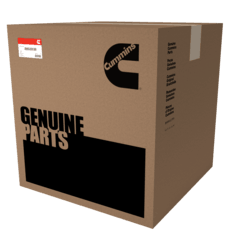This truck part is made by Cummins®. We guarantee that all of our parts are from the OEM (original equipment manufacturer), ensuring a proper fit and quality manufacturing.
We honor the warranty provided by the original equipment manufacturer.
Introduction
The Cummins 3810303 Parts Reuse Guidelines offer a structured approach to the maintenance and operation of commercial trucks. These guidelines aim to optimize the reuse of parts, ensuring efficient and sustainable fleet management. By adhering to these guidelines, fleet operators can enhance the performance and longevity of their vehicles while reducing operational costs.
Basic Concepts of Parts Reuse Guidelines
Parts reuse guidelines are based on several fundamental principles. These include the definition of reusable parts, the objectives of parts reuse, and common industry practices. The primary goal is to maximize the lifecycle of components, reduce waste, and lower the overall cost of maintenance. Reusable parts are those that can be safely and effectively used again after proper inspection, cleaning, and, if necessary, repair 1.
Purpose of the 3810303 Parts Reuse Guidelines
The Cummins 3810303 Parts Reuse Guidelines are designed to facilitate the efficient operation and maintenance of trucks by providing a clear framework for the reuse of parts. These guidelines help ensure that parts are reused in a manner that maintains safety, performance, and reliability. They also contribute to cost savings and environmental sustainability by reducing the need for new parts 2.
Key Features of the 3810303 Parts Reuse Guidelines
The Cummins 3810303 Parts Reuse Guidelines include several key features. These features may encompass detailed inspection procedures, specific criteria for part reuse, and recommended practices for cleaning and repairing parts. Unique aspects might involve innovative approaches to part evaluation and the integration of technology to enhance the reuse process 3.
Benefits of Adhering to the 3810303 Parts Reuse Guidelines
Following the Cummins 3810303 Parts Reuse Guidelines offers numerous advantages. These include significant cost savings through reduced part replacement, a positive environmental impact by minimizing waste, and improved operational efficiency. Additionally, adhering to these guidelines can lead to enhanced fleet performance and reliability 4.
Implementation of the 3810303 Parts Reuse Guidelines
Implementing the Cummins 3810303 Parts Reuse Guidelines involves several steps. Fleet operators should begin by reviewing the guidelines thoroughly and assessing their current maintenance practices. Necessary preparations may include training staff, acquiring the required tools and equipment, and establishing a system for tracking reused parts. A step-by-step approach ensures a smooth transition to the new guidelines.
Common Challenges and Solutions in Parts Reuse
Reusing parts can present several challenges, such as ensuring the quality and safety of reused components and managing inventory effectively. The Cummins guidelines offer practical solutions to these obstacles, including detailed inspection protocols, repair guidelines, and inventory management strategies. Addressing these challenges helps maintain the integrity and performance of reused parts.
Troubleshooting Using the 3810303 Parts Reuse Guidelines
When issues arise in the parts reuse process, the Cummins 3810303 Parts Reuse Guidelines provide valuable troubleshooting procedures. These may include diagnostic steps to identify problems, recommended corrective actions, and guidance on when to seek professional assistance. Effective troubleshooting ensures that parts are reused safely and efficiently.
Maintenance Practices in Conjunction with Parts Reuse
To align with the Cummins 3810303 Parts Reuse Guidelines, recommended maintenance practices should be followed. These practices may involve regular inspections, proper cleaning and repair of parts, and adherence to manufacturer specifications. Consistent maintenance helps ensure the longevity and performance of reused parts, contributing to the overall efficiency of fleet operations.
Case Studies and Examples
Real-world examples and case studies illustrate the application and benefits of the Cummins 3810303 Parts Reuse Guidelines in various fleet operations. These examples demonstrate how different fleets have successfully implemented the guidelines, resulting in cost savings, improved performance, and enhanced sustainability. They provide valuable insights and practical lessons for other fleet operators.
Training and Education
Cummins offers training programs and educational resources to help engineers, mechanics, and fleet operators understand and apply the 3810303 Parts Reuse Guidelines effectively. These resources may include workshops, online courses, and detailed manuals. Access to comprehensive training ensures that staff are well-equipped to implement the guidelines and achieve the desired outcomes.
About Cummins
Cummins Inc. is a global power leader that designs, manufactures, and distributes a wide range of power solutions. With a rich history and a mission focused on innovation and sustainability, Cummins plays a significant role in the commercial truck industry. The development of the 3810303 Parts Reuse Guidelines reflects Cummins’ commitment to providing efficient, reliable, and sustainable solutions for fleet operators.
Conclusion
Adhering to the Cummins 3810303 Parts Reuse Guidelines can lead to significant benefits for fleet operators, including cost savings, improved performance, and enhanced sustainability. By following these guidelines, operators can ensure the safe and efficient reuse of parts, contributing to the overall efficiency and reliability of their fleet operations.
References
-
Jazar, R. N. (2017). Vehicle Dynamics: Theory and Application. Springer.
↩ -
Goodnight, N., & VanGelder, K. (2019). Automotive Braking Systems CDX Master Automotive Technician Series. Jones Bartlett Learning.
↩ -
Genta, G., & Morello, L. (2019). The Automotive Chassis Volume 1 Components Design Mechanical Engineering Series 2nd Edition. Springer.
↩ -
Caines, A. J., Haycock, R. F., & Hillier, J. E. (2004). Automotive Lubricants Reference Book. SAE International.
↩
SPECIFICATIONS
RECOMMENDED PARTS
* Variable geometry turbocharger and electronic actuator repairs are not eligible to be claimed as over-the-counter under New or ReCon parts warranty for parts installed after October 1, 2018.
* Diesel Oxidation Catalyst (DOC), Diesel Particulate Filter (DPF), Selective Catalyst Reduction (SCR) catalyst, and Electronic Control Module (ECM) repairs are not eligible to be claimed as over-the-counter under New or ReCon parts warranty for parts installed after January 1, 2020.
* These restrictions are only applicable to New parts and ReCon parts coverages for the components listed above sold to a customer in the US or Canada. All other coverages are excluded. All other regions are excluded.

